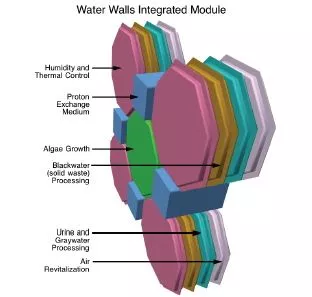When they’re living aboard spacecraft, astronauts presently rely on mechanically-driven life support systems. Not only is there a danger of these systems breaking down, but maintenance can be challenging, as they’re always in use. While redundant duplicate systems could take over in such situations, they add to the expense and weight of a spacecraft, and also take up valuable space. Instead, NASA is exploring another possibility – the passive “Water Walls” system, which would use the principle of forward osmosis to perform tasks such as water filtration, air filtration, and even food growth.
As its name implies, Water Walls would be incorporated into the “structural matrix” of the spacecraft – its inner walls, in other words – and would consist of modules of linked and layered cells. These cells would take the form of bags or tanks, made from semi-permeable polyethylene membranes that would draw in water, while filtering out unwanted substances. Some mechanization would still be required, but only to pump waste water to the modules.

There would actually be four types of cells within each module, each one chemically and biologically unique, and each performing different functions. These would include filtering the urine and other contaminants from gray water; filtering solid waste from “black water”; removing carbon dioxide and revitalizing oxygen content in the air; and, growing green algae for food. All four types of cells would also shield the crew from radiation emanating from outside the spacecraft, and help maintain the interior temperature and humidity.
Prior to lift-off, each cell would be primed with water and starter ion solutions. When the waste water then reached the modules, it would pass through each cell in sequence, via a series of valves between them. Once a cell was “exhausted,” it could be easily replaced with a spare, by crew members.
NASA has already experimented with some aspects of the Water Walls system aboard the International Space Station, using a device known as the Forward Osmosis Bag to convert astronaut's urine into a sports drink.




